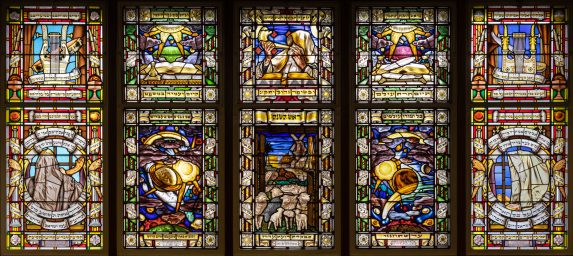St John’s Wood Synagogue, London NW8
Address
St John’s Wood Synagogue, 37-41 Grove End Rd, London NW8 9NGRecommended by
Highlight
Complete schemeArtist, maker and date
Designed by David Hillman and made by Lowndes & Drury and Joseph E Nuttgens, 1950s & 1960sReason for highlighting
This is David Hillman’s masterpiece, with over 100 separate windows – these are strikingly beautiful works of art, but more importantly, they will also inspire and educate generations of worshipers.
He appears to have cut and painted, stained and fired at least some of the windows himself. Others were made at The Glass House in the 1950s and 1960s. While later windows were almost certainly fabricated at the studio of Joseph E Nuttgens.
Artist/maker notes
David Hillman (1894-1974) was a prolific Anglo-Jewish artist who understood the deep connection between art and religion. His work is to be found in a number of London Synagogues.
Further reading: An Appreciation of David Hillman’s UK synagogue stained glass windows on the Jewish Heritage Website- David Hillman
Lowndes & Drury was formed in 1897, by the artist Mary Lowndes (1857-1929) and the craftsman Alfred John Drury (1868-1940), with the aim of providing facilities for independent artists to design and make stained glass windows. They moved from cramped conditions in Chelsea to newly purpose-built premises, The Glass House, Fulham in 1906. The firm continued after the founders’ deaths, under Alfred Drury’s son, Victor, until he retired in the early 1970s. However, The Glass House premises continued in use under Carl Edwards and subsequently his daughter, Caroline Benyon, until she moved her studio to Hampton in 1992.
Source: The Journal of Stained Glass, Vol. XLI, 2017
Joseph Edward (Eddie) Nuttgens (1892 – 1982) was born in Aachen, the son of a German father and English mother who moved to London in 1895. He developed a talent for drawing from a young age. However, being born in Germany, he was interned during the First World War and this interfered with his training and his ambition to become a portrait artist. His entry into the world of stained glass happened by chance, his drawings being seen by Arthur Orr, a stained glass artist living in Harrow, to whom he became assistant. His early influence was Burne-Jones, Christopher Whall and, at the London Central School of Art, Karl Parsons; a later influence being Eric Gill who was his neighbour.
Source: Joseph Nuttgens website



Other comments
A fine recent addition is a Tree of Life window by Ardyn and Roman Halter, 2000-01.
Further reading: The 100 Best Stained Glass Sites in London by Caroline Swash, Malvern Arts Press, 2015